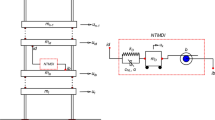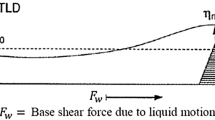Abstract
The use of an electromagnetic-tuned liquid column inerter, known as ETLCDI, for mitigating the seismic response in a nuclear containment structure has been studied. The optimization of the structure incorporating the device has rarely been reported. The recently introduced enhanced version of the traditional liquid column inerter, called the ETLCDI, has been designed to meet the demanding requirements of engineering applications. This study explores the parameters and seismic analysis FPS-based structures that incorporates ETLCDI devices. Numerical method is used to optimize the parameters of the two components of the structure, which will minimize the variations in the seismic response. The results are based on the analysis of the stationary stochastic conditions under the influence of the FPS system’s nonlinear damping. This study thoroughly examines the effects of ETLCDI on a FPS-isolated framework. The numerical analysis of the structure is performed on a 2-DOF FPS-isolated framework that is equipped with an optimal ETLCDI. It has been found that the optimized ETLCDI can effectively address both the superstructure and base floor responses during severe seismic events.
Similar content being viewed by others
Abbreviations
- M :
-
Mass matrix
- C :
-
Damping matrix
- K :
-
Stiffness matrix
- τ :
-
Force vector
- u :
-
Displacement vector
- μ t :
-
Mass ratio of TMDI
- β t :
-
Inertance ratio
- ω b :
-
Natural frequency
- ξ b :
-
Damping ratio
- ω t :
-
Natural frequency of TMDI
- ν t :
-
Frequency ratio
- ξ t :
-
Damping ratio
- ξ l :
-
Damping ratio of liquid
- V l :
-
Natural frequency ratio
- α :
-
Length ratio of liquid
- μ :
-
Friction factor of FPS
- μ l :
-
The mass ratio of liquid
- μ c :
-
The mass ratio of tube
- R :
-
Radius of the FPS
References
M. Kelly James, Base isolation: linear theory and design, Earthquake Spectra, 6(2) (2012) 223–244.
M. Kelly James, The role of damping in seismic isolation, Earthquake Engineering and Structural Dynamics, 28(1) (1999) 3–20.
A. Dario De Domenico et al., Novel fluid inerter based tuned mass dampers for optimized structural control of base-isolated buildings, Journal of the Franklin Institute, 356(14) (2019) 7626–7649.
J. N. Yang and D. Wong, On aseismic hybrid control system, Structural Safety and Reliability ASCE, New York, USA (1990) 471–478.
A. Taniguchi Tomoyo, D. Kiureghian and M. Melkumyan, Effect of tuned mass damper on displacement demand of base-isolated structures, Engineering Structures, 30(12) (2008) 3478–3488.
G. Hernán, O. Curadelli and D. Ambrosini, Improvement of tuned mass damper by using rotational inertia through tuned viscous mass damper, Engineering Structures, 56 (2013) 2149–2153.
S. Xue et al., Mechanics and dynamics of intelligent passive vibration control system, Journal of Engineering Mechanics, 123(4) (1994) 322–327.
Y. Arfiadi and M. N. S. Hadi, Hybrid base isolation-passive mass damper systems, Eighth International Conference on Computing in Civil and Building Engineering, Stanford, USA (2000).
J. S. Love, M. J. Tait and H. Toopchi-Nezhad, A hybrid structural control system using a tuned liquid damper to reduce the wind induced motion of a base isolated structure, Engineering Structures, 33(3) (2011) 738–746.
M. Reiterer and F. Ziegler, Bi-axial seismic activation of civil engineering structures equipped with tuned liquid column dampers, Journal of Seismology and Earthquake Engineering, 6(3) (2004) 45–60.
A. Ahmet Can, A. Yetisken and V. Kahya, Experimental study on control performance of tuned liquid column dampers considering different excitation directions, Mechanical Systems and Signal Processing, 102(1) (2018) 59–71.
M. C. Smith, Synthesis of mechanical networks: the inerter, IEEE Transactions on Decision and Control, 47(10) (2002) 1648–1662.
L. Marian et al., Optimal design of a novel tuned massdamper-inerter (TMDI) passive vibration control configuration for stochastically support-excited structural systems, Probabilistic Engineering Mechanics, 38 (2014) 156–164.
X. Liu et al., Model identification methodology for fluid-based inerters, Mechanical Systems and Signal Processing, 106 (2018) 479–494.
Q. Wang et al., Wind-induced response control of high-rise buildings using inerter-based vibration absorbers, Applied Sciences, 9(23) (2019) 5045.
D. Pietrosanti, M. De Angelis and M. Basili, Optimal design and performance evaluation of systems with tuned mass damper inerter (TMDI), Earthquake Engineering and Structural Dynamics, 46(8) (2017) 1367–1388.
C. Li and W. Qu, Optimum properties of multiple tuned mass dampers for reduction of translational and torsional response of structures subject to ground acceleration, Engineering Structures, 28(4) (2006) 472–494.
J. Abdollah and N. E. Wierschem, Optimal design of rotational inertial double tuned mass dampers under random excitation, Engineering Structures, 165(15) (2018) 412–421.
M. Saitoh, On the performance of gyro-mass devices for displacement mitigation in base isolation systems, Structural Control and Health Monitoring, 19 (2012) 246–259.
T. Hashimoto et al., Innovative base-isolated building with large mass-ratio TMD at basement for greater earthquake resilience, Future Cities and Environment, 1 (2015) 9.
Q. Feng et al., Optimal tuned inerter dampers for performance enhancement of vibration isolation, Engineering Structures, 198(1) (2019) 109464.1–109464.14.
D. De Domenico, N. Impollonia and G. Ricciardi, Soil-dependent optimum design of a new passive vibration control system combining seismic base isolation with tuned inerter damper, Soil Dynamics and Earthquake Engineering, 105 (2018) 37–53.
D. Pietrosanti, M. De Angelis and A. Giaralis, Experimental seismic performance assessment and numerical modelling of nonlinear inerter vibration absorber (IVA)-equipped base isolated structures tested on shaking table, Earthquake Engineering and Structural Dynamics, 50(10) (2021) 2732–2753.
D. De Domenico and G. Ricciardi, An enhanced base isolation system equipped with optimal tuned mass damper inerter (TMDI), Earthquake Engineering and Structural Dynamics, 47(5) (2018) 1169–1192.
M. Alberto Di et al., Optimal design of tuned liquid column damper inerter for vibration control, Mechanical Systems and Signal Processing, 167 (2022) 108553.
S. V. Bakre and R. S. Jangid, Optimum parameters of tuned mass damper for damped main system, Structural Control and Health Monitoring, 14(3) (2007) 448–470.
W. O. Wong and Y. L. Cheung, Optimal design of a damped dynamic vibration absorber for vibration control of structure excited by ground motion, Engineering Structures, 30(1) (2008) 282–286.
K. Steen, Dynamics of Structures, McGraw-Hill, USA (1975).
M. De Angelis et al., Optimal tuning and assessment of inertial dampers with grounded inerter for vibration control of seismically excited base-isolated systems, Engineering Structures, 196(1) (2019) 109250.1–109250.19.
T. I. Hsu and M. C. Bernard, A random process for earthquake simulation, Earthquake Engineering and Structural Dynamics, 6(4) (2010) 347–362.
A. Di Matteo et al., Direct evaluation of the equivalent linear damping for TLCD systems in random vibration for pre-design purposes, International Journal of Non-Linear Mechanics, 63 (2014) 19–30.
M. Oliva, G. Barone and G. Navarra, Optimal design of nonlinear energy sinks for SDOF structures subjected to white noise base excitations, Engineering Structures, 145(15) (2017) 135–152.
P. Spanos, Stochastic linearization in structural dynamics, Applied Mechanics Reviews, 34(1) (1981) 1–8.
V. M. Pan’Kin, Influence of damping on the calculation results of the vibration parameters of the support of a turbinegenerator set with an attached dynamic vibration damper, Power Technology and Engineering, 54(3) (2020) 394–397.
M. Eroğlu, M. Akif Koç, İ. Esen and R. Ko-zan, Realistic modelling for analysis of train-structure and ballasted-track interaction for high-speed trains, Journal of Vibration Engineering and Technologies, 26 (2023).
A. Di Matteo et al., Optimal tuning of tuned liquid column damper systems in random vibration by means of an approximate formulation, Meccanica, 50(3) (2015) 795–808.
E. Ismail and M. A. Koc, Optimization of a passive vibration absorber for a barrel using the genetic algorithm, Expert Systems with Applications, 42(2) (2015) 894–905.
Acknowledgments
The project was financially supported by the China National Nuclear Corp.’s Youth Talent Development Project, Project name: Key technologies and testing validation of an enhance base-isolation structure of Hualong-1 nuclear power plants, Project No: KY90200210017.
The project was supported by a collaboration between the Board of Education of Yantai City and Harbin Engineering University, Project name: Interdiscipline of nuclear science and civil hydraulic engineering- construction of nuclear plants and nuclear safety, Project No: 22MZ03CD012.
The project was supported by the key R&D plan of the province of Heilongjiang, Project name: Digital Research on three-dimensional isolation and vibration reduction technology for nuclear heating nuclear, Project No:2022ZX01A14.
Author information
Authors and Affiliations
Corresponding author
Additional information
Han Guangcai, Ph.D. born in 1966, is serving as the Professor of civil and aerospace engineering at the Harbin Engineering university. He is dedicated to teaching and conducting research related to multibody system dynamics and vibration control. His research interests include the study of the dynamic behavior of flexible rotating blades, the control of vibration in actuators on ships, and the use of energy equations for high-order mechanical systems. He has also conducted studies on armored vehicles and the analysis of elastic mechanics.
Rights and permissions
About this article
Cite this article
Han, G., Wu, Y., Hou, G. et al. Optimal design of earthquake-resistant containment for FPS-Isolated nuclear power plants with electromagnetic tuned liquid column damper inerter. J Mech Sci Technol 38, 579–594 (2024). https://doi.org/10.1007/s12206-024-0107-z
Received:
Revised:
Accepted:
Published:
Issue Date:
DOI: https://doi.org/10.1007/s12206-024-0107-z




